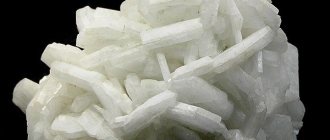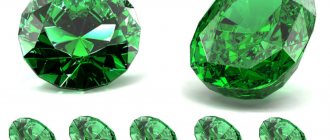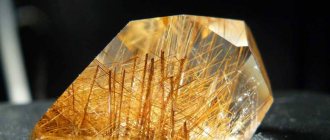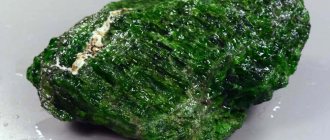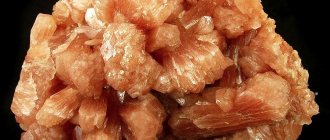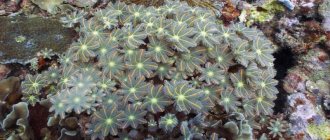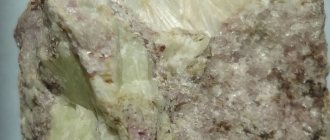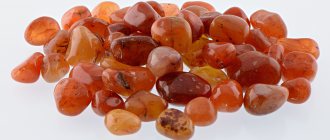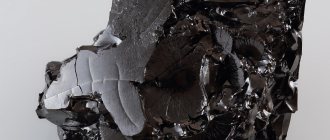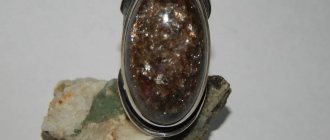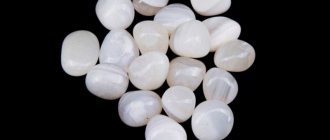Seeing this translucent stone with a delicate green tint for the first time, an inexperienced person will decide that this is a natural emerald. But this is a misconception. In fact, it is a copper emerald, very similar in appearance to a natural stone, but has a different chemical composition and properties. Dioptase (akhirite, ashirite) is a rare mineral that belongs to the group of copper silicates.
It gets one of its names from its characteristic deep dark green color. It is more fragile than a gemstone and is less hard, which is why it is not used very often in jewelry.
Some historical facts
In the second half of the 18th century, merchant Ashir Zaripov discovered these stones in the mountains of Kazakhstan. He was sure that he had become the owner of real emeralds. The merchant sold them to an English officer, who at that time served in the Russian army. Several copies were brought to St. Petersburg. Here the find was named in honor of the merchant - the stone ashirite (asharite). Only eight years later, T. Lovitz, a Russian scientist, having carefully studied the mineral, found out that the find was not an emerald, but a copper silicate. Since then it has been called “pseudo-emerald”.
The famous mineralogist from France R. Gayuy gave the mineral its scientific name - dioptase, which consists of two Greek words. They can be translated as “observing through,” which characterize the translucency of the stone. Due to its resemblance to precious emerald, the mineral is used to make high-quality imitations of it.
During the reign of Catherine II, the dioptase stone was very popular at court. Any noble lady could boast of exquisite jewelry with inserts of raw crystals.
Dioptase - copper emerald from the Kazakh steppes
“In the 18th century, around the nineties, by the highest will of Empress Catherine the Great of blessed memory, to survey the borders of the Siberian line according to political types, Brigadier Bentham, who was then in the Russian service, was sent by His Serene Highness Prince Potemkin, who, in addition to this command, was... to go as far as possible in the interior of the steppe of the Kirghiz of the middle horde and compose a map for your route, depending on the circumstances, as correct as possible.
Bukharan Ashir, who had been in the Kyrgyz steppes many times for his trades, presented to Brigadier Bentham at the Koryakovsky outpost pieces of copper ore with green crystals similar to emeralds, and announced that he took them from an ancient mine in the Kyrgyz steppe, by noon from the Koryakovsky outpost at 300 verst.
Brigadier Bentham, mistaking this fossil for a true emerald, respected it all the more since the survey of its deposit could serve as a decent pretext ... to go abroad and thereby fulfill the will of the government with the slightest difficulty, concealing its true appearance.”
I. P. Shangin. “Historical news of the discovery of dioptase with a brief description of its deposit.” "Proceedings of the Imperial St. Petersburg Mineralogical Society", 1 volume, 1830.
From the dossier:
Dioptase is a mineral, hydrous copper silicate. Hardness 5.0-5.5 on the Mohs scale, density 3.28-3.35 g/cm3, glass luster. Other names: copper emerald, kirghizite, ashirite, achirite, dioptasite, emerald malachite, emeravdine, Russian emerald.
A full member of the Mineralogical Society, I.P. Shangin, spoke in a report about his expedition and the history of the discovery of the Altyn-Tube deposit in Kazakhstan by an earlier expedition, approved by Catherine the Great. After this, Dioptase began to be called the emerald from the Kyrgyz steppes, since central Kazakhstan was then called the Kyrgyz steppes, and the locals called it the Kyrgyz people. Bentham's first expedition, led by Ashir Bey Muhammad, a merchant from Bukhara, was unsuccessful: Bentham had only managed to lay a pit (small mine) and extract some dioptase when several hundred hostile and armed local residents appeared, which is why the expedition had to be urgently interrupt.
The extracted mineral samples were brought to St. Petersburg. “Scientific mineralogists, who received from Bentham several samples of an imaginary emerald, valued them like a miser with gold or like an Egyptian with a mummy, barely daring to touch them with their fingers, much less subject them to a chisel, and even less to a chemical test,” writes I.P. in his report. Shangin. The same Ashir, even before Bentham, brought samples of dioptase to Semipalatinsk, and people began to talk about them in the capital, for example, St. Petersburg academician Johann Ferber wrote an article about it as an emerald. It was after this that Bentham set off on an expedition at the highest command.
So, dioptase became a celebrity, and the crystals obtained by the Englishman were so few that they regretted using them for composition research. “This fossil was accepted by almost all mineralogists in Europe as a type of emerald, solely because of its similarity in color to this latter. The Imperial Russian Academy of Sciences called it ashirite, after the name of the Bukharian Ashir, who discovered it, and acted in this case very decently, without rejecting the opinions of others and without asserting its own - until the time when the true deposit of this fossil is discovered, more samples will be delivered, other minerals accompanying it will be described and, in a word, correct information will be obtained about everything that serves to determine the characteristics of ashirite according to the accepted systems.”
And so it happened. Dioptase received its modern name in 1797 thanks to the mineralogist Rene-Juste Haüy, the founder of crystallography, who decided to immortalize the appearance of dioptase crystals in this name (from the Greek diá - through, through and optázo - I see). “I see through” - not because the crystals are transparent (otherwise more than one thousand minerals could be called this), but because of the numerous cleavage cracks visible inside the stone. Dioptase is very fragile, that is, it easily splits and even crumbles in certain directions. Haüy discovered a difference in the structure of the crystal lattice of dioptase from emerald.
The new mineral was nevertheless studied by chemists, despite the attractive appearance of the gem and the lack of samples to find out its exact composition. It turned out that ashirite is not an emerald or its variety at all, but a mineral still unknown to science, consisting of copper oxide, water and silica. It was first studied by the St. Petersburg chemist Tovius Lowitz, then by Louis Nicolas Vauquelin and Abraham Gottlieb Werner. The results were consistent. The German Werner gave the second name to dioptase - copper emerald. Under this name it was known for a long time in Germany.
Due to the fact that Central Kazakhstan was poorly explored and the maps were drawn up with errors, for a long time no one could say exactly where the dioptase deposit was. The only one who knew the right path was Ashir, but he refused to lead people there - he believed that he had received little reward, and after his death there was no one at all to do it. Therefore, the mineral was practically rediscovered in 1816 by I.P. Shangin and his team in a copper ore deposit on Mount Altyn-Tyube, near the Altyn-Su river - completely by accident. Only then was it described and mapped.
Due to its resemblance to emerald, dioptase is called its younger brother. Like emerald, dioptase usually forms short-columnar, prismatic crystals, hexagonal, with strong luster, collected in druses of bright emerald green and blue-green color. They can be either transparent or opaque. Only the top of dioptase crystals is pointed, while that of emerald is poorly developed. Typically, dioptase crystals do not exceed one to three centimeters in length; There are granular aggregates, geodes, thin veins, and crusts. Dioptase can often be found together with calcite, quartz, chrysocolla, malachite, and azurite.
Dioptase is a rare mineral, therefore it has not found use as a copper ore; good cleavage and low hardness have become an obstacle to its widespread use in jewelry, despite its excellent color and luster. Sometimes you can find jewelry with dioptase from some masters: its raw crystals and brushes set in metal look very impressive. In icon painting it is used as a source of mineral pigment. But by and large, dioptase is a collectible stone and, as such, very expensive.
The formation of dioptase is associated with the process of weathering of copper ore deposits, so it can be found in places with a hot, arid climate. This is the already mentioned Kazakhstan (Altyn-Tube), as well as Chile, Peru, Argentina, the USA (the states of California, Nevada, New Mexico, especially Arizona), Mexico, Morocco, Zaire, Namibia, Congo, South Africa, southern Australia.
For a long time, the deposit in Kazakhstan was the only known source of dioptase, then gradually it began to be found in other places, and in the twentieth century the richest African deposits were discovered in the Congo and Namibia. At one time, dioptase was even called Congolese emerald. The Namibian deposit in Tsumeb supplies such beautiful and numerous specimens in comparison with other places that over time it even began to be considered almost the first where dioptase was found. In the 1980s there was a real boom in dioptase from Namibia.
However, dioptase is also found in Europe and Russia in the Urals. It would seem that these are not at all hot and dry areas where it should be born, but such a climate was not always present here. In ancient times, when copper ore deposits were formed and then weathered, the climate in Europe and the Urals was much drier and warmer. Therefore, dioptase is found in the Czech Republic in Karlovy Vary, and in Romania in Rezbanya, and in France, Italy and Germany.
And the tales of P. P. Bazhov are associated with dioptase deposits in the Urals; Copper emerald is mentioned in the tale “The Mistress of the Copper Mountain,” and the tale “Sochnevy Pebbles” is generally entirely devoted to dioptase. Many invited German craftsmen worked in the Ural mines, so dioptase was called copper emerald there.
Dioptase is considered a stone that awakens love and heals the heart, calms emotional storms and relieves the effects of stress.
Lithotherapists suggest wearing brooches and pendants with dioptase, as it has a positive effect on cardiovascular activity and also activates mental activity. Dioptase is considered a stone that brings good luck in business, allowing you to quickly concentrate on the task at hand and find the answer to a complex question, which is why it has gained fame as a talisman for students and businessmen.
This is one of the favorite stones of lithotherapists, who consider dioptase to help cleanse and clarify consciousness, relieve negative emotions and protect against them. Astrologers recommend wearing dioptase to Capricorns , Virgos , Taurus and Libra ; least of all it suits Aries . Copper emerald is an unusual stone. Surprisingly beautiful, with a rare color, it stands out among its brothers in the kingdom. But it is short-lived, afraid of water, and its beauty is fragile - squeeze it too hard, and it can crumble. According to Pavel Petrovich Bazhov, rare copper emeralds are not given into the hands of bad people. A gem is like happiness, which is difficult to hold in your hands, and its possession is a test.
Description of copper emerald
Although scientists consider the mineral to be just a fake of a precious emerald, many stone lovers consider it incredibly beautiful. The exquisite color - from delicate emerald to rich dark green - is mesmerizing. There are even minerals that have a blue tint. Dioptase stone consists of silica and copper oxide. Its crystals crumble and break easily. In crushed form, they have long been used by icon painters as a green pigment.
The characteristics of a copper emerald are noticeably different from a gemstone. Its density is lower. The edge of the crystal at the fracture is conchoidal, stepwise uneven. At the same time, ashirite is a valuable and rare mineral. Dioptase has a pronounced glass luster. On planes this shine can be pearlescent.
Physical and chemical properties
Dioptase belongs to the class of copper silicates (copper oxide - 50.5%, silica - about 38%, water - about 11%) - hence the name “copper emerald”. The color range of the mineral varies from emerald shades of green to blue-green colors. A characteristic feature of the crystals is low density and fragility, the structure ranges from dense to fine-grained.
Basic physicochemical properties of dioptase.
| Formula | Сu6[Si6О18]×6H2O |
| Molecular weight | 157 |
| Color | From emerald green to dark green, rarely with a bluish tint |
| Shine | Glass, mother-of-pearl |
| Transparency | Transparent or translucent |
| Hardness | from 5 to 5.5 |
| Cleavage | Perfect |
| Kink | uneven to splintered |
| Density | from 3.28 to 3.35 g/cm3 |
| singonia | Trigonal |
| Crystal shape | Rhombohedral or short prismatic |
The mineral is soluble in acids, turns black in an oxidizing flame, but practically does not melt under a soldering iron.
Place of Birth
Copper emerald is not mined as an accompanying rock; it is isolated only in the form of a pure crystal. It is often replaced in deposits by chrysocolla and is usually found adjacent to limonite, malachite, calcite or azurite.
The largest deposits of the mineral are located in Eurasia, North and South America, and Africa. In Europe, ashirite deposits are located in Italy. In Africa, the mineral is found in Congo, Namibia and Zaire. Here it is highly valued. The copper emerald has been awarded the status of a national symbol.
Areas of use
Dioptase is not widely used in jewelry, although jewelry made from it is very beautiful. The size of the crystals rarely exceeds two centimeters, so they are used for making only small products. Minerals of no more than two carats are processed using emerald cut. The mineral pigment Ashirite is still used to paint icons today.
Natural healer
The powerful energy of copper emerald has found application in lithotherapy. When heated, the mineral helps treat diseases of the upper respiratory tract, heart and blood vessels, relieves irritability, and calms the nervous system. Adherents of this treatment method believe that sessions with dioptase are indicated for pregnant women and patients who have suffered a heart attack or stroke. A pendant, brooch or amulet with a copper emerald is recommended to be worn at chest level by everyone who suffers from pathologies of the heart and blood vessels.
Dioptase improves the condition of respiratory tract diseases, including ailments affecting the trachea, throat and bronchi. In such a situation, it is advisable to wear an amulet with this mineral around the neck.
Traditional healers use ashirite powder to treat wounds that take a long time to heal. A brooch or pendant pinned to clothing helps ease breathing in people suffering from asthma. The healing properties of this mineral can relieve overexcitation and lift a person out of depression. To do this, you need to have a small crystal of a green healer with you.
Talismans and amulets
Dioptase loves hard work and honesty and rewards such people with well-deserved success, so amulets and amulets with a stone have a particularly beneficial effect on people seeking the truth and engaged in important work. The mineral patronizes scientists, philosophers, lawyers, and doctors.
Copper emerald also attracts prosperity and wealth, so a talisman with a green crystal will not hurt people associated with business and finance: bankers, entrepreneurs, accountants, economists and financiers.
Feng Shui experts recommend keeping a talisman with a dioptase stone on the southeast side of the apartment. This part of the home is responsible for financial well-being. The amulet will enhance positive energy flows and help attract material wealth.
One of the conditions for the positive impact of any talisman is the right choice. Before purchasing an amulet, astrologers recommend holding the stone you like in your hands and listening to your feelings and sensations. If warmth arises inside, this is your stone and talisman that will bring good luck and prosperity. If a mineral causes coldness and negative emotions, it is better to pay attention to another crystal.
Magic of stone
For a long time, green color has been considered a symbol of financial well-being and prosperity. Matters related to financial flows require prudence and calm from every person. And here you cannot do without the magic of copper emerald. It is these qualities that the mineral brings into the life of its owner.
You may have met women who constantly wear copper emerald jewelry: over time, they look especially impressive and attractive. Men with this stone are distinguished by determination in business and confidence in their abilities. However, the mineral does not contribute to the creation of families.
According to magicians, a person who has owned a stone for a long time experiences a close connection with the mineral. The copper emerald seems to teach its owner to read and understand the thoughts of the people around him, and warns against hasty and rash actions. The stone cleanses karma, teaches people to feel and sympathize with other people's pain, and not only physical.
The magical properties of dioptase
Dioptase stone has long been famous for its amazing magical properties, which are partly similar to the energy of emerald. Dioptase is considered a talisman of success in work and business. The magic of the stone enhances ability to work, helps in making the right decisions, promotes career growth, and attracts material wealth and wealth.
In addition, the mineral also helps people of mental work - scientists, pupils and students. It enhances the sharpness of thinking, helps to concentrate, increases the perception of material, and activates the internal resource.
It is believed that with strong mental contact with the owner, dioptase not only brings good luck, but is also able to read surrounding information and transmit it to the owner in the form of dreams or symbolic clues.
Jewelry with stones gives women femininity and attractiveness in the eyes of the stronger sex, and men - a boost of vivacity, self-confidence and energy.
However, it is worth considering that dioptase carries material, not spiritual energy, and if used incorrectly, it can negatively affect your personal life and love relationships.
Who is Ashirit suitable for?
The mineral does not tolerate signs whose representatives are prone to fraud, deception, and adventurous actions. These include Scorpios, Capricorns, Aries. Copper emerald not only will not help them, but can also harm them.
He is more favorable to other signs. Prefers enterprising Cancers, ambitious Leos, and practical Virgos. And ownership of this stone will bring positive changes in fate to everyone else, but on condition that their actions and thoughts are open and aimed at the benefit of others.
Jewelry and products made from dioptase
Despite the fact that this stone has a low hardness index, jewelry craftsmen make beautiful products and unique jewelry from it. It is preferable to process dioptase with an emerald cut. In this case, the stone exceeds 2 carats and can be used for inserts in jewelry. Sometimes intergrowths of crystals of natural origin are also used for inlay.
Craftsmen mainly insert this mineral into women's and men's rings, pendants and brooches. In some cases, it is used to decorate beads, necklaces and bracelets. This kind of jewelry has an impressive cost - from 100,000 to 200,000 rubles.
As a talisman or amulet, dioptase is primarily undesirable for such zodiac signs as Aries, Capricorn and Scorpio. The energy of this stone will help Cancers, Leos and Virgos achieve success in their careers. Decorating with this stone can also help the remaining signs of the zodiac in a difficult situation, but provided that the person himself is open, friendly and his thoughts are pure.
